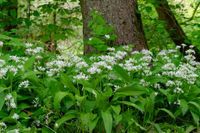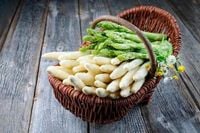As spring unfolds, the allure of foraging for wild garlic, known as ail des ours, draws many nature enthusiasts into the woods. However, this seemingly innocent pursuit can hide a dangerous risk, as the toxic plant colchicum lurks in the underbrush, often mistaken for the edible variety. Between 2020 and 2022, poison control centers reported 28 cases of confusion between colchicum and ail des ours or wild leek, tragically resulting in two fatalities.
The National Agency for Health Security (ANSES) has issued warnings and advice as the peak for these mix-ups occurs from March to May, particularly in the Grand Est and Auvergne-Rhône-Alpes regions. During this critical period, foragers are urged to be vigilant and informed, as the consequences of misidentification can be severe.
According to ANSES, half of the individuals who suffered from poisoning had prepared the leaves in pesto sauce, while the other half consumed them in salads, stir-fries, or quiche. The symptoms of colchicum poisoning can range from mild to life-threatening, depending on several factors, including the amount ingested and the presence of certain medications that may exacerbate the toxicity.
Among those affected, half reported pronounced or prolonged symptoms such as persistent diarrhea or vomiting. Four individuals experienced severe symptoms that posed serious health risks, including critical digestive, hepatic, and hematological disorders. The agency emphasizes that all parts of the colchicum plant are toxic, and even small amounts can lead to significant health issues.
Identifying ail des ours is crucial for safe foraging. This wild garlic can be recognized by its characteristic garlic scent when crushed, its star-shaped white flowers, and its shiny, oval, pointed leaves that grow on stems. In contrast, colchicum features more rigid leaves that emerge directly from the ground without stems, a round and dark bulb, and lacks the garlic odor. Its flowers, which are purple, bloom only in the fall.
To ensure a safe foraging experience, ANSES recommends several precautions. Foragers should only pick plants they can positively identify, check for the garlic scent on each leaf, and avoid harvesting leaves in bulk to prevent mixing edible and toxic species. If any bitter or unpleasant taste is detected, consumption should cease immediately. Additionally, taking photographs of the harvest can aid in identification should any health issues arise.
The rise in cases of confusion highlights the need for increased awareness and education among foragers. The dangers associated with misidentifying these plants can lead to serious health consequences, and the public is encouraged to familiarize themselves with the distinct characteristics of ail des ours and colchicum.
As the spring season welcomes foragers into the wild, the message from health authorities is clear: enjoy the bounty of nature, but do so with caution and knowledge. By taking the time to learn about the plants you are foraging, you can enjoy the flavors of spring while minimizing the risks.
The critical period for confusion peaks in April, making it essential for foragers to be particularly vigilant during this time. The regions most affected, including Grand Est and Auvergne-Rhône-Alpes, have seen a notable uptick in reported cases, underscoring the importance of education and awareness in preventing future incidents.
In light of these alarming statistics, it is important for local health departments and community organizations to step up their efforts in educating the public about safe foraging practices. Workshops, informational pamphlets, and community events can play a significant role in spreading awareness about the risks of plant misidentification.
Moreover, social media platforms can serve as valuable tools for sharing information and connecting with experienced foragers who can offer guidance and tips. By fostering a community of informed foragers, the risks associated with wild plant foraging can be significantly reduced.
As the trend of foraging continues to grow in popularity, it is imperative that enthusiasts remain educated and cautious. The thrill of discovering and enjoying the flavors of wild plants should not come at the cost of health and safety. By taking the necessary precautions and educating themselves about the plants they encounter, foragers can enjoy the beauty and bounty of nature while staying safe.
Ultimately, the message is simple: knowledge is power when it comes to foraging. By understanding the differences between ail des ours and colchicum, individuals can safely enjoy the pleasures of wild garlic without falling victim to its toxic counterpart.
As spring unfolds, may the joy of foraging be accompanied by safety and awareness, ensuring that nature's gifts can be enjoyed without peril.





